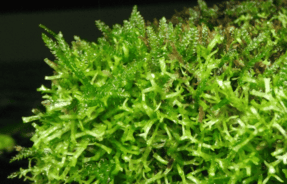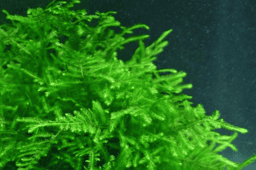Aquarium Moss With The Lowest Maintenance?
Aquarium plants and especially aquarium moss provides a tremendous value to your fish tank.
What aquarium moss has the lowest maintenance? – The Java moss has the lowest maintenance and can grow on any surface. The moss feeds from the water through its leaves and stems. It is so hardy that not much care needs to be done to keep it growing. Java moss can grow in low to medium light and has a water temperature range that is very manageable at 70-85 degrees.
Benefits of Fish Tank Moss
Reduces algae
Growing moss in your fish tank will take away the nutrients that algae need to grow. Moss grows much faster than algae and because of this the moss will end up starving the algae from the nutrients it needs to survive. Algae will never be totally eliminated but can be controlled by reducing its growth.
Adds oxygen into the water
The carbon dioxide that is released by your fish will be used by the moss plants and will release oxygen into the water. This oxygen is a critical piece of the puzzle for fish to stay healthy and be the best they can be. This is the most natural way to extract carbon dioxide from the tank and add oxygen for your fish well being.
It creates a natural habitat for the fish.
The majority of the fish that you will have in your fish tank come from rivers and because of this their instincts and natural habitat setting is drawn from this. A fish will feel more comfortable when this is occurring. Moss, as well as other plants, provide this natural habitat.
Fish will feel more secure by having a place to shelter. These moss plants will also provide a natural feeling place for the fish to breed and lay their eggs.
Secures the bottom substrate.
The bottom of your fish tank has a layer of either sand or gravel. This is a key part of your tank to grow necessary elements in the biological cycle process and provide a natural habitat feeling for your fish.
When moss grows it will help to secure this substrate material and can keep the bottom of your fish tank more secure from movement. This can be caused by digging fish and water flows over time.
It provides a pleasing look to your fish tank.
I know some hobbyists get nervous over the thought of having another living creature in your fish tank and opt-out for artificial plans. While these will add interesting effects to your tank, real moss plants take it to another level.
When moss is growing on your rock structures and the bottom substrate it gives the most natural feel and enjoyment for you as an observer and your fish who live it.
Water Conditions Factors
| Moss Types | Water Temperature (Degrees Fahrenheit) | pH Levels |
|---|---|---|
| JavaMoss | 57 – 86 | 6.0 – 8.0 |
| Christmas Moss | 68 – 82 | 5.5 – 7.5 |
| Flame Moss | 68 – 83 | 6.0 – 7.5 |
| Willow Moss | 59 – 82 | 5.5 – 8.5 |
| Star Moss | 73 – 86 | 6.0 – 7.5 |
| Peacock Moss | 65 – 77 | 5.0 – 7.5 |
| Weeping Moss | 59 – 86 | 5.0 – 6.0 |
| Taiwan Moss | 53 – 86 | 5.0 – 8.0 |
| Pellia Moss | 45 – 86 | 5.5 – 8.0 |
| Riccia Moss | 59 – 86 | 6.0 – 70 |
What may impact moss?
Algae growing on the moss will take away the visually pleasing effect that the plant provides. As a result, algae should be gently removed from the moss when it first appears and this will return the moss to its original beauty.
When fish feed on the moss it can distort the shape and can negatively impact the health of the moss plant. It is best to plan ahead and not introduce fish that are known to feed on moss plants.
Moss Types
Java Moss
Java Moss is the most popular and in the majority of fish tanks. Furthermore, Java moss can grow on your substrate bottom material such as gravel or sand. The moss can also grow on rocks, driftwood or other tank decoration surfaces.

Java Moss does not have roots that provide its nutrients as it absorbs its nutrients through its stems and leaves.
Java moss is extremely hardy and does not require much maintenance as it can grow in lower light environments and the water condition does not have much effect on its ability to grow. It will thrive in the water at a temperature of 70-75 degrees Fahrenheit. The cooler the water the faster it will grow versus slower growth in warmer water.
Breeder tanks that raise fish find cover for the small fry and eggs in the Java Moss. This provides protection from larger fish that will disturb and destroy the young.
Keeping the java moss trimmed is a maintenance requirement. If this is not done on a regular basis the moss can overwhelm your tank and potentially clog your filters.
The algae growth caused by excessive light and poor water quality can overtake it.
Christmas Moss
Propagating Christmas moss is easy and can be accomplished by snipping a piece off the plant and attach to a piece of rock structure. It typically tanks about 2-3 weeks to attach and begin to thrive.
No additional extra fertilizer or nutrients are required. It will grow from the nutrients in the fish tank water.

Flame Moss
Flame moss has roots growing in an upward direction and gives it an exotic look. The moss has a very dark green color making it one of the more colorful mosses you can put in your tank. The growth of the moss can be bushy and will require more clipping to keep its growth under control and not overtaking the fish tank.

Willow Moss
Willow moss has a resemblance to willow trees. It has a thick branch and stem system that provides for bigger leaves. As light increases, the willow moss will tend to get darker. With less light, the moss can start to brown.
Willow moss prefers colder water to thrive and because of this, it is harder to maintain due to most fish require a warmer water condition.

Star Moss
Star moss has a low growing height and can be compared to a lawn. The moss grows in a density and its leave are shaped in small stars. Star moss is not a moss that is typically not for beginners and the maintenance can be difficult.

Peacock Moss
Peacock moss grows in bushy patches and its growth compares to that of pine trees. It will easily attach to any type of rocks, decorations and substrates. It is considered as a good beginner’s moss and requires little to no maintenance.
It is commonly used as an alternative to the most popular Java moss. It will grow with low light conditions and with little to no additional supplements.

Weeping Moss
Weeping moss grows on any type of rock, decorations and it grows with overhanging shoots that are compared to a weeping willow tree. It is easy to grow and maintain and any type of fish tank. Weeping moss has low light requirements and it is a slower growing moss. The only maintenance required is to keep it trimmed to enhance its appearance.

Taiwan Moss
Taiwan moss is compared to a mini version of weeping moss. It is a fairly new moss type being used in fish tanks. It grows up to 2 inches thick and has a vibrant green color. It will absorb extra water nutrients very well to help slow down algae growth. It is easily propagated and will grow on any type of surface. It is easy to maintain and a good beginner moss.

Pellia Moss
Pellia moss is a floating type of plant and must be attached to structures to keep it in place. As it gets larger it will sink and can be placed accordingly. It grows in most conditions and low light. It is a slow-growing and very hardy moss. Overall maintenance is not bad other than managing its floating nature.

Riccia Moss
Riccia moss will grow up to 2 inches and it will float if not tied down on a structure. It is a fast-growing moss and requires regular trimming. It grows in thick clumps and has short vivid thread growths. While Riccia moss provides advantages for improving water conditions it is probably not a starter moss for beginners.

What is a Moss Ball?
The topic of fish tank moss introduces some confusion from the name itself. The moss balls are actually not a moss at all. They are algae that grow into a large ball. You will often see the phrase “Marimo Moss Ball”. It is a Japanese word with the meaning of a seaweed ball.

As a result, Marimo moss balls have entered the aquarium scene in the last few years. They are very pleasing to the eye and are a nice addition to a fish tank.
Marimo Moss balls are beneficial to fish tanks and easy to maintain. For additional information to refer to our article Marimo Moss Balls: What You Need to Know that covers these in-depth.